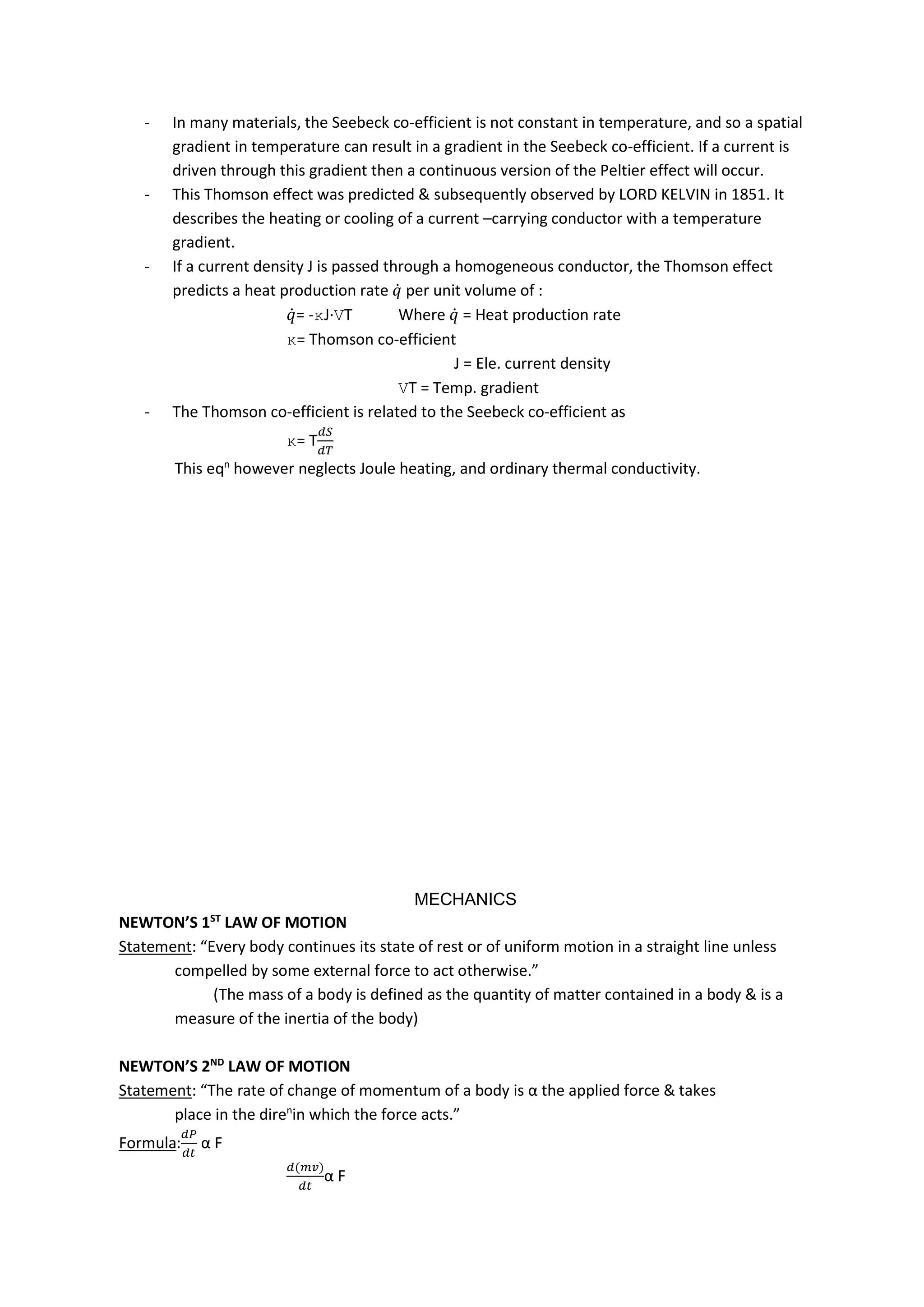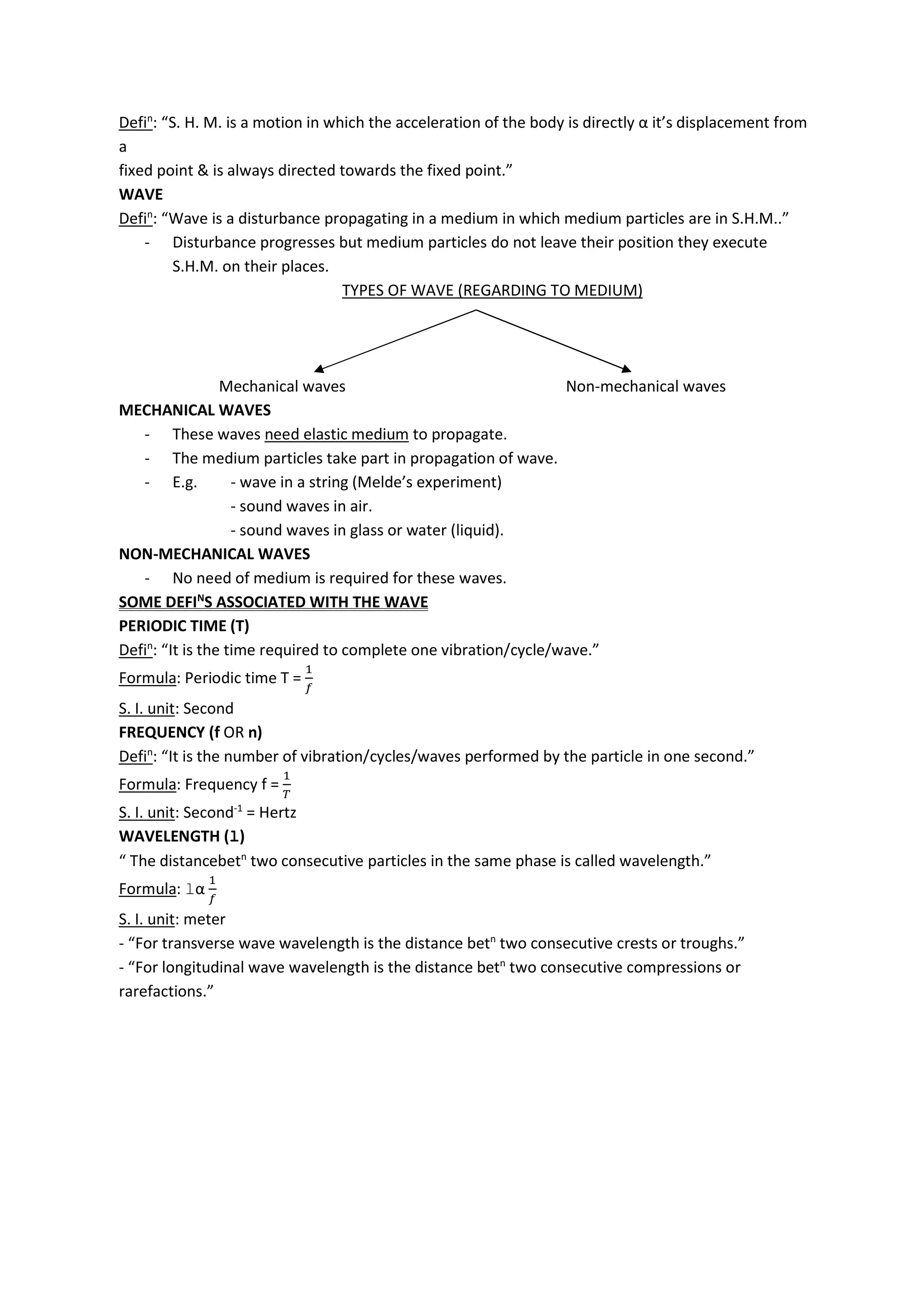This document summarizes key concepts in electricity and magnetism, mechanics, and waves and sound. It defines Coulomb's inverse square law, electric field intensity, electric potential, electric current, electric current density, Ohm's law, electric resistivity, conductivity, Kirchhoff's laws, and other important electrical concepts. It also outlines Newton's laws of motion, the law of universal gravitation, and defines gravitational field. Finally, it discusses types of motion, simple harmonic motion, defines key wave properties like period, frequency, and wavelength, and distinguishes between mechanical and non-mechanical waves.
![COULOMB’S INVERSE SQUARE LAW
Figure:
Statement: “The magnitude of the electrostatic force of interaction betn
two point charges is
directly proportional to the scalar multiplication of the magnitudes of charges and
inversely proportional to the square of the distance between them.”
Math. Formula:
Fα q1q2/r2
F = kq1q2/r2
(where k= Coulomb’s constan
= 1/4πε0
= 8.98 x 109
Nm2C-2)
ε0 = 8.85x 10-12 farad/m
= 8.85x 10-12 C2N-1m-2
ELE. FIELD OR ELE. FIELD INTENSITY OR ELE. FIELD STRENGTH (E)
Defin
:“Ele. field or ele. field intensity is defined as the ele. force per unit charge.”
- The diren
of field is taken to be the diren
of the force it would exert on a +ve test charge.
- The ele. Field is radially outward from a +ve charge &radially in toward a –ve point charge.
Formula:
Ele. Field intensity (E) =
( )
( )
S. I. unit:
( )
( )
= NC-1
or
( )
( )
= Vm-1
[NC-1
= =
∙
∙
= ∙
= =Vm-1
]
ELE. POTENTIAL OR ELE. POTENTIAL DIFFERENCE
Defin
:“The work required to transfer a unit +ve charge from an infinite distance to a given point
against an ele. Field.”
Formula:
Ele. Potential =
( )
( )
S. I. unit:
Volt (V) =
( )
( )
= J∙C-1
ELE. CURRENT (I)
Defin
: “Ele. Current is defined as the rate at which charge flows through the cross section of a wire.”
Formula:
Ele. Current (I) =
( )
( )
S. I. unit:](https://image.slidesharecdn.com/fundamentalofb-220101054233/75/Fundamental-of-b-physics-english-1-2048.jpg)

![“The inverse of the conductivity of the material is known as resistivity.”
Formula:
Resistivity (ρ) =
∙
[̣ ˙ ̣˙ Rα =ρ ]
or
Resistivity (ρ) = 1/conductivity (σ)
S. I. unit:
Ohm ∙ meter = Ω∙m
ELE.CONDUCTIVITY (σ)
Defin
: “It is the reciprocal of ele. resistivity& measures a material’s ability to conduct an ele.
current.”
Formula:
conductivity (σ) = 1/Resistivity (ρ)
S. I. unit:
∙
= (Ω∙m)-1 = Ʊ∙m-1 = mho∙m-1
JUNCTION
Defin
: “Junction is a circuit points at which currents divide.”
Figure :
LOOP
Defin
: “A closed circuit formed with conductors is known as a loop.”
Figure :
KIRCHHOFF’S 1ST
LAW OR KIRCHHOFF’S CURRENT LAW (KCL) OR KIRCHHOFF’S JUNCTION/NODAL
RULE
Statement: “The algebraic sum of currents in a network of conductors meeting at a junction (node)
is zero.”
or
“At any node (junction) in an ele. circuit, the sum of currents flowing into that node is
equal to the sum of currents flowing out of that node.”
Formula:
At any junction O
I1 - I2 + I3 - I4 - I5 = 0
SI = 0
KIRCHHOFF’S 2ND
LAW OR KIRCHHOFF’S VOLTAGE LAW (KVL) OR KIRCHHOFF’S LOOP RULE
Statement: “The algebraic sum of the product of the resistance of the conductors & the currents in
them in a closed loop is equal to the total emf available in that loop.”
or
“The sum of the emfs in any closed loop is equivalent to the sum of the potential
drops in that loop.”](https://image.slidesharecdn.com/fundamentalofb-220101054233/75/Fundamental-of-b-physics-english-3-2048.jpg)
![or
“The directed sum of the ele. pote. diff.s (voltage) around any closed network is zero.”
Figure :
Formula:
-I1R1 + E1 + I2R2 - E2- I3R3 + I4R4 + I5R5= 0
-I1R1+ I2R2- I3R3 + I4R4 + I5R5 = - E1 + E2
SIR = SE
ELE. ENERGY (W) OR (E)
Defin
: “The work done by the battery to keep flow of charges continuously is known as ele. energy.”
Formula:
W = VQ [˙ ̣˙ V = W/Q ]
W = V It [ ˙ ̣˙ Q = It ]
W = IR It [ ˙ ̣˙ Ohm’s law, V = IR ]
Ele. energy W = I2
Rt (1)
Eqn
(1) is known as Joule’s law.
S. I. unit: Joule (J)
Other :-Ele. pote. energy is a pote. energy that results from conservative Coulomb forces and is
associated with the configuration of a particular set of point charges within a defined system .
- The term “Electric pote. energy” is used to describe the pote. energy in systems with time-
variant ele. fields, while the term “Electrostatic pote. energy” is used to describe the pote.
energy in the systems with time invariant electric fields.
ELE. POWER (P)
Defin
: “Ele. power is the rate at which ele. energy is transferred (converted to other forms) by an
ele.
circuit.”
or
“ Ele. power is the rate of energy consumption in an ele. circuit.”
or
“The ele. power (P) is equal to the energy consumption (E) divided by the consumption time
(t).
Formula:
Ele. Power (P) = Work done per unit time = =](https://image.slidesharecdn.com/fundamentalofb-220101054233/75/Fundamental-of-b-physics-english-4-2048.jpg)
![P =
= I2
Rt/t
= I2
R
= IV [ ˙ ̣˙ Ohm’s law, IR = V ]
= V2
/R [ ˙ ̣˙ Ohm’s law, I = V/R ]
S. I. unit:
( )
( )
= Watt (W)
JOULE CONSTANT
- To convert heat energy and mechanical energy into eachother.
Formula:
W = JH W = Mechanical energy in Joule
H = Heat energy in Calorie
J = Joule constant
Where J is known as Joule’s constant.
It is also known as the mechanical equivalent of heat.
Application of Joule Heating :
1. Common application in fuse used in ele. circuit.
2. Ele. Iron, bread toaster, ele. kettle, ele. heater etc.
3. Producing light in incandescent bulb.
THERMO ELECTRIC EFFECT
THERMO ELE. SERIES
- The thermo ele. series is a set of elements that can be used to build thermocouples & which
participate in the Seeback effect & it’s inverse, the Peltier effect.
- As you move the two elements you are using closer in the table, the thermoele. Yield goes
down, as it does when you reduce the temp. difference.
- So the ele. production depends on, (1) Types of the metal used from thermo ele. series.
(2) Temp. diff. betn
junctions of the thermocouple.
SEEBECK EFFECT
- The Seebeck effect is the conversion of tem. differences directly into electricity & is named
after the BALTIC GERMAN PHYSICIST THOMAS JOHANN SEEBECK, who, in 1821, discovered
that a compass needle would be deflected by a closed loop formed by two different metals
joined in two places, with a temp. differencebetn
the junctions. This was a thermoele.
Circuit composed
FIGURE
of materials of different Seebeck co-efficient (P-doped & n-doped semiconductors),
configured as a thermoele. Generator. If the load resistor at the bottom is replaced with a
voltmeter the circuit then functions as a temp. sensing thermocouple because the metals](https://image.slidesharecdn.com/fundamentalofb-220101054233/75/Fundamental-of-b-physics-english-5-2048.jpg)



